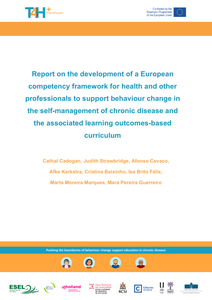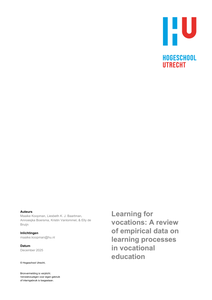Contemporary education increasingly involves a blended learning environment, which consists of a combination of offline and online delivery methods. Blended learning environments can motivate students to learn, but designing motivating blended learning environments is challenging and can result in environments that demotivate students. This conceptual article proposes a blended learning design that helps practitioners to design motivating blended learning environments. According to self-determination theory, students are motivated to learn when their three basic psychological needs for autonomy, competence, and relatedness are supported. Competency-based education (CBE) is intended to support students’ basic psychological needs. We have constructed design guidance for CBE programmes that help practitioners to design a combination of offline and online delivery methods that (1) give students choices in time and place to support their need for autonomy, (2) adapt to students’ competency levels to support their need for competence, and (3) stimulate students’ relationship building with peers and teachers to support their need for relatedness. Although the design guidance is tentative, practitioners can experiment with it to design blended learning environments that motivate students to learn.
DOCUMENT

From the article The paradigm shift towards competency-based education in the Netherlands has a logical counterpart: the need for more flexibility in the curricula. After all, in competency-based education it is recognized that learning not only takes place in designated places (school, university), but may happen every time when the learner is confronted with a challenge. This observation leads to the necessity to incorporate the learning outcomes of formal and informal education in one curriculum. As a result, the educational process becomes more complex and must be better structured to control the individual learning outcomes. In this paper we discuss this paradox: how more flexibility in the program creates the need for more control in the process. We also discuss what kind of IT-tools are helpful in controlling flexibility in curricula for higher professional education.
MULTIFILE

Chronic diseases represent a significant burden for the society and health systems; addressing this burden is a key goal of the European Union policy. Health and other professionals are expected to deliver behaviour change support to persons with chronic disease. A skill gap in behaviour change support has been identified, and there is room for improvement. Train4Health is a strategic partnership involving seven European Institutions in five countries, which seeks to improve behaviour change support competencies for the self-management of chronic disease. The project envisages a continuum in behaviour change support education, in which an interprofessional competency framework, relevant for those currently practising, guides the development of a learning outcomes-based curriculum and an educational package for future professionals (today’s undergraduate students).
DOCUMENT

This book provides insight into an ambitious project to re-invent the educational method practiced at NHL Stenden. The predecessors used different approaches to the delivery of education. One of them used Competency-Based Education, whilst the other practiced Problem-Based Learning. The choice to combine the advantages of both methods, as well as to develop an entirely new concept that provided a better response to the fast and ever-increasing pace of changes in the workplace, was made by both institutions together. This approach was called Design-Based Education (DBE). Given the significant changes required of stakeholders to facilitate learning according to the new DBE approach, it is important to take stock of what these changes mean in terms of teaching and learning and to ascertain from early steps how everybody can stay, or step, on board.
DOCUMENT

Over the past decade, the maker movement and in its slipstream maker education have attained worldwide popularity among educators, politicians, and the media. Makers’ enthusiasm for creative design and construction, using old and new tools has proven contagious, and is worth exploration and critical reflection by the community of engineering and technology education (ETE). This chapter describes what has been said about “making” by philosophers and educators; what maker education is, and what is new and not so new about it; why it has gained momentum; what the evidence is about its effectiveness and its possible weaknesses; and how mainstream technology education may benefit from maker education. This chapter concludes with ideas for a research agenda.
LINK
This open access book is a valuable resource for students in health and other professions and practicing professionals interested in supporting effective change in self-management behaviors in chronic disease, such as medication taking, physical activity and healthy eating. Developed under the auspices of the Train4Health project, funded by the Erasmus+ program of the European Union, the book contains six chapters written by international contributors from different disciplines. This chapter sets the stage for the remaining book, by introducing the Train4Health project and by explaining how the learning outcomes presented in subsequent chapters have been derived and linked with content of the book. Firstly, the Train4Health interprofessional competency framework to support behaviour change in persons self-managing chronic disease is briefly presented. This European competency framework was the starting point for developing the learning outcomes-based curriculum, which is succinctly addressed in the subsequent section. Finally, practical considerations about the Train4Health curriculum are discussed, including opportunities and challenges for interprofessional education.
LINK
Honours programs are selective programs that offer challenging educational opportunities for talented students who are willing and able to do more than regular programs offer them (Wolfensberger et.al.,2012). For optimal learning, these programs should focus on three dimensions of teaching approaches: community building; enhancing academic competence, and offering freedom. The amount of freedom in honours education is the most distinguishing aspect from regular programs (Wolfensberger,2012), however, also for honoursstudents an amount of structure is needed to enhance engagement (Lang et.al.,2010) and performance (Locke & Latham,2006; DeShon & Alexander,1996). Explicit learning outcomes can be a way to provide this strucure. In the Netherlands, honours programs of Higher Education Institutions (HEI) aim to prepare students to become the excellent professional of the future. Since it is not clear which competencies define this excellent professional, each institution determines the learning outcomes for their honours students. For instance, Hanze University of Applied Sciences (UAS) focusses on how the working field defines an excellent professional, developing an evidence-based competency profile specific for each discipline. Rotterdam UAS, developed the profile for Innovative Action for all disciplines, and Saxion UAS established the Reflective Professional profile to define learning outcomes for their honours students, both based on literature research. In a collaborative project, these three aforementioned HEI gathered honours programs descriptions of 8 HEI to assess overlapping competences they adopt as learning outcomes for honours students. Preliminary results indicate substantial overlap and an alignment between working field perceptions and available literature.In this session, the following issues will be discussed: •The added value and content of competency profiles defining learning outcomes in honours education;•how specific these profiles should be (discipline-specific or general);•the added value and possibility of a shared (inter)national honours competency profile;•potential risks: limiting freedom in honours education, cultural differences regarding definition of excellence. Description of the session (100 words): the session starts as focus group discussion facilitated by a moderator and concentrating on the question: Which competences / learning outcomes should honours programs concentrate on? Aim is to explore opinions and views of the participants. Afterwards three higher education institutes present shortly the competencies and learning goals they adopt. Next, a round table discussion takes place, based on statements. Participants choose their position (pro or con) before the discussion starts, discus their views, and indicate afterwards whether their opinion is changed. Aim is to indicate pro’s and con’s for (inter)national uniform honours competences and learning goals.
DOCUMENT
Numeracy and mathematics education in vocational education is under pressure to keep up with the rapid changes in the workplace due to developments in workplace mathematics and the ubiquitous availability of technological tools. Vocational education is a large stream in education for 12- to 20-years-olds in the Netherlands and the numeracy and mathematics curriculum is on the brink of a reform. To assess what is known from research on numeracy in vocational education, we are in the process of conducting a systematic review of the international scientific literature of the past five years to get an overview of the recent developments and to answer research questions on the developments in vocational educational practices. The work is still in progress. We will present preliminary and global results. We see vocational education from the perspective of (young) adults learning mathematics.
LINK
The Ecocentric and Anthropocentric Attitudes toward the Sustainable Development (EAATSD) scale measures environmental concern in relation to sustainable development. This article will discuss how this scale was tested with three groups of Dutch higher education students. Findings demonstrate that anthropocentric and ecocentric values are independent of the students’ chosen course of study, suggesting that students attracted by the ‘sustainable development’ course title do not necessarily associate ‘sustainability’ with ecocentric aims. This article discusses why ecocentric values are beneficial to the objective of a sustainable society and proposes ways forward in which these values can be enhanced in learners. https://doi.org/10.3390/educsci7030069 https://www.linkedin.com/in/helenkopnina/
MULTIFILE

This article reports on a literature review on empirical research investigating learning for vocations in the context of vocational education. We included 36 studies in which learning for vocations is empirically studied. Learning for vocations is characterised based upon prevalent research traditions in the field and framed from the perspective of vocational education and organised learning practices. This framing and characterisation directed the search terms for the review. Results show empirical data on vocational learning and illustrate how learning processes for the functions of vocational education - vocational identity development, development of a vocational repertoire of actions, and vocational knowledge development - actually take place. The review further shows that, empirical illustrations of learning processes that occur in the context of vocational education and organised learning practices are relatively scarce. The findings can be typified in relation to our theoretical framework in terms of three learning processes, that is learning as a process of (a) belonging, becoming, and being, (b) recontextualization, and (c) negotiation of meaning and sense-making. We argue that more empirical research should be carried out, using the functions of vocational education and the three learning processes to better understand vocational learning.
DOCUMENT
